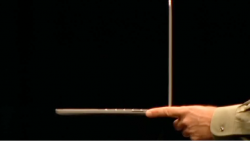I want to give you the knowledge you need to design your next presentation like a pro.
I’ve recently made a presentation for a student who had to discuss his Master thesis to an audience on his graduation day. I’m going to use that presentation as an example for you to learn 10 basic design concepts that will take your presentations to the next level.
(The slides are in Italian, but I only want you to focus on the design. For the purpose of this article, the language and the content don't matter).
(1) Start strong
The first slide is the most important one. It sets the tone for what comes next. You need to use it to arouse curiosity. You want your audience to get intrigued. A high-quality image that supports your topic is always a good choice. This before-after slide shows you how most students would design the first slide of their Master thesis presentation and how they really should design it. Which one do you prefer?
(2) Use the rule of three
The rule of three is one of the most important concepts in communication theory. It means that people can only hold about three pieces of information in short-term memory. Therefore, split your presentation into three separate sections. I know this cannot always be done—but when possible find a way to use this rule. You’ll give your narrative structure and make sure your audience will remember your [three] main points. Apple uses this trick all the time.
(3) Never use bullet points
One of the main reasons why Death by PowerPoint is in everybody’s vocabulary today is bullet points. There is always an alternative to the boring bullets. An idea is to use icons instead.
(4) Display data effectively
The key to displaying data for maximum impact is to leave out all the elements that don’t add value to an audience’s understanding of your message. I’ve recently interviewed Rick Altman, host of the Presentation Summit. Speaking about data display, he said “most of the time you are sharing proportional data, [that is] how this thing relates to that thing. You could do that with two rectangles, one of them being longer than another one.”
How often do you really need a background? Do you need the lines across it? The answer, my friend, is no you don’t. In many cases you don’t even need the axes.
Extra tip: don’t use the title of your chart as the title of your slide. Instead, use a short message that tells the story behind the data. In the slide below, instead of “GDP and public debt” I wrote “Debt raises while GDP stays flat”. You’ll make it easier for your audience to immediately grasp the meaning of your chart. Remember, what’s important is not the data, but the story behind the data.
“What’s important is not the data,
(More on data display here)
(5) Use hierarchy
If one element is more important than another, show it! One way to do that is by using hierarchy. Here’s how I used it in this slide:
- Title: Raleway Bold, 36 points
- Chart legend: Raleway Regular, 30 points
- Source and numbers: Raleway Light, 20 points
From a visual point of view, the tile is more important than the legend, which in turn is more important than the data source.
(6) Go big or go home
If there is one thing you really want your audience to remember, make it big. If it’s important for your listeners to know the inflation rate is 1.2%, then that’s what you should do. Again, Apple does it all the time.
(7) Combine images and text
In visual communication, there are few things more powerful than a high-quality image combined with text. By no coincidence billboards are often designed that way. They need to grasp people’s attention in a matter of seconds—and so should your slides.
Extra tip: Use the rule of thirds. Imagine to break down your slide into thirds—both vertically and horizontally—so that you have four intersecting points. Then place the key elements of your visual either along one of the dividing lines or on the intersecting points.
Extra tip 2: Apply the same filter to your images. Here’s a small trick: create a rectangular shape of the colour you want to use for setting the tone of your presentation and place it underneath each of your images. Then substantially reduce the opacity so that the shape fades away. In my presentation I’ve used a blue shape and brought the opacity down to 20%. If you look carefully, each image has a blue tone.
Extra tip 3: Make sure images and text flow into each other. Notice where this woman is looking at? She is exactly looking at the text. I haven’t placed the text there by coincidence. As soon as you show such a slide, people will naturally look at the woman first and then follow her eyes towards the text. That’s exactly what you want them to do.
(8) Use colour wisely
I’ve already written about colour theory here and how to apply the theory here. To sum up, don’t use random colours. For example, the reason why I’ve used blue, red and white is because those are the national colours of Japan. Also, I didn’t use any red, but rather the same red as in the Japanese flag. (I then adjusted the shade to make it stand out better).
(9) Achieve unity
You may be thinking that some of these tips are too meticulous to even get recognised. However, it all adds up. If you apply them, you’ll come up with a unified presentation where all the elements work together to support your design as a whole. You’ll make sure your elements don’t compete with each other, but rather support each other towards a common goal of communicating your message. You’ll make sure your elements belong together.
(More on achieving unity here).
(10) Give credits
Never use somebody else’s images or design elements without giving appropriate credit. As one said, ”Render unto Caesar the things that are Caesar's, and unto God the things that are God’s.”
If you want to take your presentations to the next level, please reach me out at andr.pacini@gmail.com.
IMAGE: Nathanael Coyne via Flickr























